In-Depth Look at the John Deere Wheel Rake for Farmers
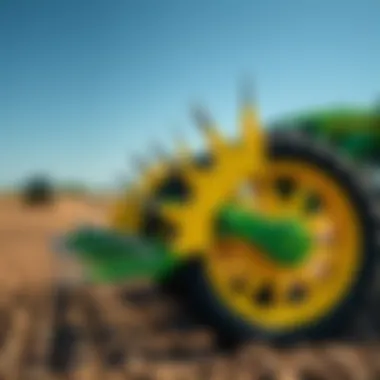
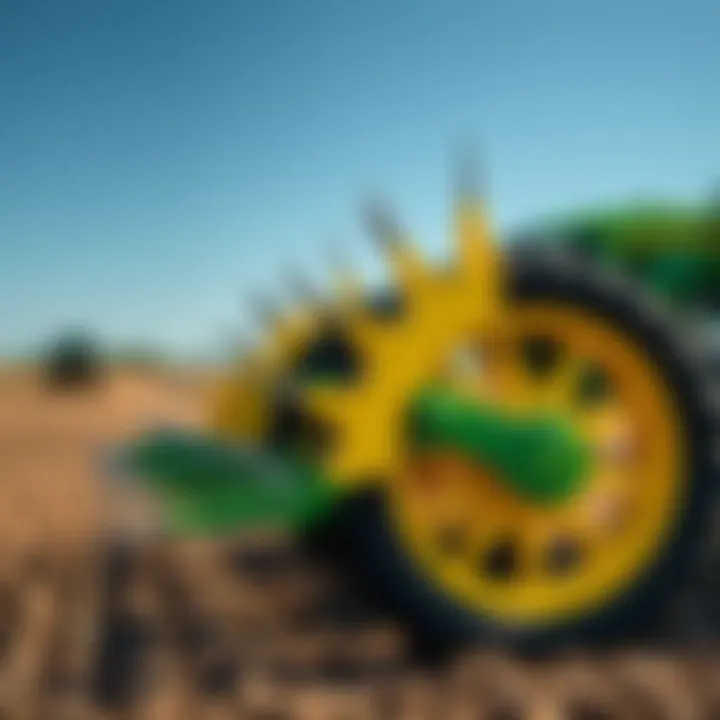
Intro
The agricultural landscape is ever-evolving, and with it comes a plethora of implements designed to facilitate various farming tasks. One such implement, the John Deere wheel rake, has emerged as a game changer in the arena of haymaking. Farmers and enthusiasts alike understand that effective hay management is crucial to optimizing yield and ensuring livestock health. The purpose of this article is to provide an in-depth exploration of the John Deere wheel rake, highlighting its design, functionalities, advantages, and operational considerations. As we journey through this overview, we promise to touch on the importance of this tool in modern agriculture while also contrasting various models to aid informed purchasing decisions. This comprehensive guide seeks to empower those involved in agriculture with the knowledge needed to enhance efficiency and productivity on the field.
Key Concepts and Terminology
Basic Definitions
Understanding the John Deere wheel rake requires familiarity with several key terms:
- Wheel Rake: A machine designed to gather hay or other crops into windrows, preparing them for baling or further processing.
- Windrow: The line or row formed when hay is gathered, making it easier to dry before storage.
- Tines: The long, slender projections on a rake that pick up materials from the ground.
Historical Context
The use of wheel rakes dates back several decades, evolving from simple manual tools to sophisticated machinery. Initially, these rakes were operated by hand or horse-drawn implements. The introduction of tractors transformed the industry, bringing efficiency and speed. John Deere, with its legacy rooted in agricultural innovation, began producing wheel rakes that blended functionality with durability. Over the years, various models have been developed to suit differing needs and preferences, which we will explore in detail later.
Recent Innovations and Trends
Technological Advancements
In recent years, wheel rakes have witnessed considerable advancements. Today, they feature:
- Hydraulic Controls: Making adjustments to the rake's position easier while on the move.
- GPS Integration: This tech assists in ensuring accurate operations, especially for larger fields.
One notable example is the John Deere 8 Series, which boasts precise control systems enhancing overall usability.
Sustainable Practices
Agriculture is leaning towards more sustainable methods, and the John Deere wheel rake demonstrates this shift. By improving the efficiency of hay collection, these rakes minimize waste and reduce the time crops spend on the field, ultimately impacting fuel consumption positively.
Practical Applications and Techniques
Step-by-step Guides
Understanding how to use the John Deere wheel rake properly can maximize performance:
- Preparation: Ensure the field is clear of debris that might obstruct operations.
- Set-up: Adjust tire pressures and rake positioning according to field conditions.
- Operation: Start the tractor and engage the rake, moving slowly for effective collection.
- Windrow Formation: Ensure the tines are positioned correctly to create consistent windrows without damaging the crop.
- Post-Operation: Inspect the equipment for wear and tear and perform necessary maintenance, which is key for longevity.
Case Studies
A local farmer in Iowa shared their experiences with the John Deere wheel rake's efficiency. After switching from a traditional rake to the Model 1560, they reported:
"Our hay collection speed has doubled, and the quality of the windrows has improved significantly—yielding better feed for our cattle."
Such firsthand accounts highlight the tangible benefits of investing in this equipment.
Closure
The John Deere wheel rake undeniably offers a multitude of advantages for modern farming. From efficiency and technological advancements to sustainable practices and practical applications, it’s a key player in haymaking operations. As you consider which model to invest in, reflect on your specific needs, fields, and operational preferences. Well-informed choices today will yield productive results tomorrow.
For more detailed information and specific model comparisons, visit:
Foreword to Wheel Rakes
In the fast-paced world of agriculture, efficient machinery can be the linchpin of successful operations. When it comes to haymaking, wheel rakes emerge as an essential tool that enhances productivity while reducing labor costs. This section will introduce you to the concept and function of wheel rakes, specifically focusing on those designed by John Deere, a brand synonymous with agricultural excellence.
Concept and Functionality
A wheel rake operates on a straightforward yet effective principle: it gathers and arranges hay into windrows. Unlike traditional methods, which may involve multiple manual steps, the wheel rake integrates technology with ease of use. Imagine being able to transform freshly cut grass into neatly organized rows with just a single pass through the field. This is the essence of a well-designed wheel rake.
Understanding the components is critical. Typically, a John Deere wheel rake features multiple curved wheels mounted on an adjustable frame. These wheels systematically comb the grass, lifting it without damaging the delicate stems, thereby preserving the quality of the forage. Factors like the rake’s width and wheel configuration can significantly affect the efficiency of the harvesting process.
Importance in Agriculture
The importance of wheel rakes in agriculture cannot be overstated. As the pressure to maximize yield increases, the need for efficient haymaking methods grows as well. Here are a few key points illustrating their significance:
- Time Efficiency: Time saved during harvest means more time for other essential tasks on the farm, from planting to maintenance.
- Labor Reduction: Automated tools decrease the reliance on manual labor, especially in tasks that are repetitive and strenuous.
- Quality Preservation: By minimizing contact with the ground, wheel rakes help in maintaining the quality of the hay, which is vital for livestock nourishment.
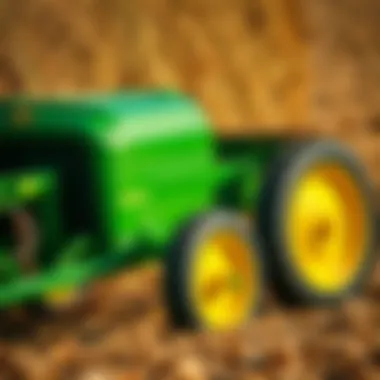
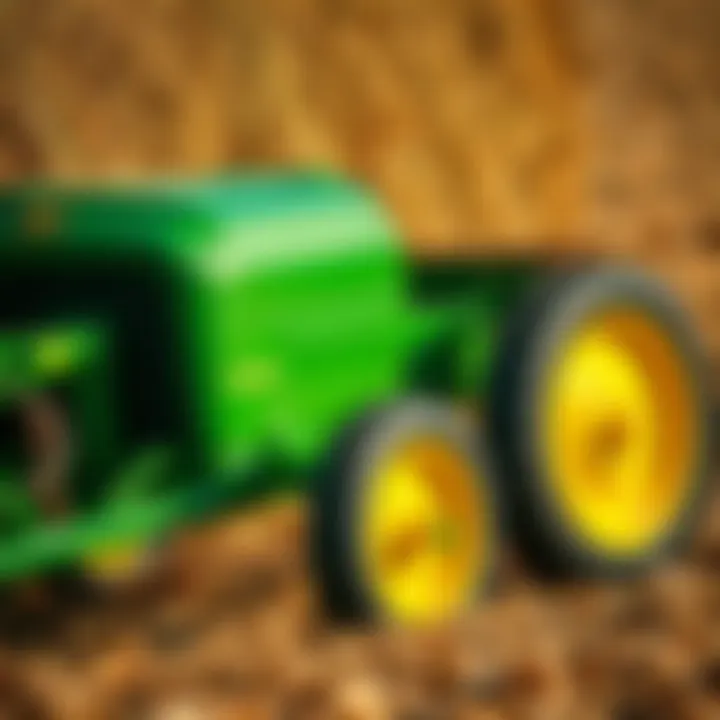
As farmers face the often unpredictable challenges of weather and market demand, the reliability and efficiency offered by wheel rakes help to keep operations running smoothly. With their ability to improve both productivity and efficiency, wheel rakes truly represent a forward-thinking solution in modern agriculture.
"Investing in the right equipment today can mean the difference between flourishing fields and struggling harvests tomorrow."
In short, understanding wheel rakes' concept and functionality gives farmers a powerful edge in optimizing their agricultural practices.
Understanding John Deere Wheel Rake Models
When it comes to haymaking, knowing what machinery is available can be a game changer. Focusing on John Deere wheel rake models gives farmers the insight needed to make choices that suit their specific needs. Each model is crafted with particular features targeted at enhancing efficiency, reducing labor, and maximizing yield. Getting familiar with the available options ensures informed decisions that align with both operational goals and budget constraints.
Overview of Available Models
John Deere offers a variety of wheel rake models, each designed to cater to different types of haying operations. When examining these models, it's important to appreciate the balance of functionality and adaptability they present. For instance, the John Deere 660R is notable for its heavy-duty construction and efficiency, making it ideal for larger fields and tougher crop conditions. Meanwhile, the John Deere 680R is appreciated for its ease of use in more moderate operations, focusing on flexibility and lighter-duty tasks.
These models typically come with various rake widths that can influence performance based on the setup of your fields. For instance, the wider rakes can cover more ground in less time, crucial for producers looking to manage extensive hay operations efficiently.
Some features across the models that stand out are:
- Adjustable Rake Wheels for varying terrain
- Durable Construction that can withstand harsh conditions
- Height Adjustment capabilities, which is essential for various crop types
These specifications not only define the machine's limitations but also highlight its potential.
Specifications Across Models
Specifications form the backbone of understanding machinery performance. Each John Deere wheel rake model boasts distinct features that can impact a farmer's decision based on their specific requirements. Here are some common specifications across models:
- Rake Width: Models like the 660R have an adjustable rake width, usually ranging from 10 to 18 feet, which is excellent for tackling different field sizes.
- Wheel Design: Most John Deere rakes come with a unique wheel configuration that helps minimize ground disturbance while maximizing hay collection efficiency.
- Weight Capacity: Heavier models can handle denser crops, ensuring the rake remains effective even when dealing with thick hay, an essential consideration during harvest time.
With these specifications, it becomes obvious that understanding the parameters guiding the models can streamline decision-making for farmers. Each model's capabilities lead to better management of resources and potentially higher profits at the end of the season.
Design Features of John Deere Wheel Rakes
When it comes to the world of agricultural equipment, the design features of John Deere wheel rakes stand out as a testament to innovation and functionality. These features are not mere embellishments; they serve crucial roles in enhancing efficiency and effectiveness in haymaking. A focus on these elements reveals how well-thought-out designs can cater to the unique demands of farmers, making their tasks more seamless and productive.
Construction Materials and Durability
The first thing that catches the eye in any John Deere wheel rake is its robust construction. The materials used are as tough as they come. Typically, high-strength steel frames and alloyed components form the backbone of these rakes. Such choice of materials ensures they can weather the battering of constant use in demanding environments.
The durability doesn’t just stop at the frame; components like the raking wheels are designed to withstand wear from various terrains. Farmers might notice that while some rakes flaunt shiny exteriors, it’s the inner workings and the resilience of these materials that hold real value. Investing in a wheel rake built from solid materials often translates to reduced long-term costs due to fewer repairs and replacements.
Rake Wheel Configuration
Next on the list is the rake wheel configuration. Unlike other implements, the arrangement of the rake wheels in a John Deere wheel rake is meticulously designed to optimize the performance. Depending on the model, these wheels are positioned for maximum effectiveness in gathering and lifting hay.
For instance, some models feature a patented design that allows the wheels to flex as they move over uneven terrain. This adaptability helps in maintaining consistent contact with the ground, ensuring a thorough and efficient raking process. Additionally, the number of wheels can influence the quantity of material being processed at any given time. More wheels can mean more efficient collection, translating to faster work on the field. Farm machinery isn't about aesthetics; it’s about output and productivity in the fields.
Height Adjustment Mechanisms
Finally, let’s touch on height adjustment mechanisms. The ability to modify the working height of a wheel rake is a game-changer for farmers. John Deere’s models allow for quick and precise adjustments to suit different types of crops and soil conditions. This feature is particularly significant when transitioning between fields or dealing with varying crop residues left from previous cuts.
Farmers often find themselves in changing situations where a quick tweak can save time and effort. The height adjustment not only affects the efficiency of raking but also ensures that crops are not damaged during the process. The gearing mechanisms involved are engineered for smooth and easy operation, so even in the heat of the moment, adjustments can be made with confidence.
In sum, the design features of John Deere wheel rakes encompass a wide array of considerations that come together to enhance agricultural efficiency. From durable materials to thoughtful configurations and adjustable heights, each element supports the essential roles these rakes play in haymaking. Understanding these features gives farmers an edge when choosing their equipment, safeguarding both their investment and productivity in the field.
Operational Efficiency in Using Wheel Rakes
Operational efficiency in utilizing wheel rakes, specifically those produced by John Deere, remains a cornerstone of modern hay production. Understanding how to maximize the performance of these machines can significantly influence a farmer’s productivity and bottom line. The optimal application of a wheel rake translates not only into financial savings but also enhances the quality of the harvested product.
Optimal Operating Speed and Conditions
Finding the right speed and environmental conditions to operate a wheel rake is essential to achieving effective hay collection and management. The optimal operating speed typically ranges from 4 to 8 miles per hour, but this can vary depending on several factors such as the type of crop, the condition of the field, and the specific model of the rake being used.
The following points highlight crucial considerations for speed and conditions:
- Crop Dryness: Ensure that the hay is sufficiently dry before raking; operating on wet hay can cause clumping and impede the rake’s effectiveness.
- Soil Conditions: Avoid operating wheel rakes in overly wet or muddy fields. These conditions can result in damage to the soil and hinder the rake's mobility.
- Adjustment of Rake Wheels: Adjusting the rake wheels to match the height of the crop can improve efficiency. If the rake is set too low, it may gather too much soil; if set too high, it might miss smaller clumps of hay.
It’s always wise for farmers to observe local weather patterns and adjust accordingly, as these can greatly impact both the speed and the technique employed.
Techniques for Enhanced Productivity
To truly harness the potential of a John Deere wheel rake, consider implementing various techniques that have proven to enhance productivity. Here are several strategies:
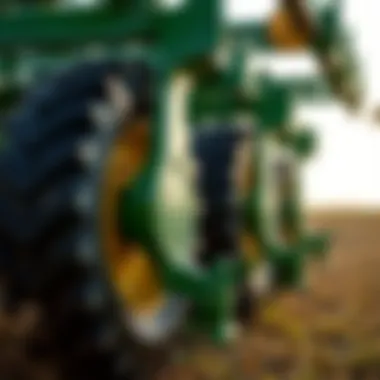
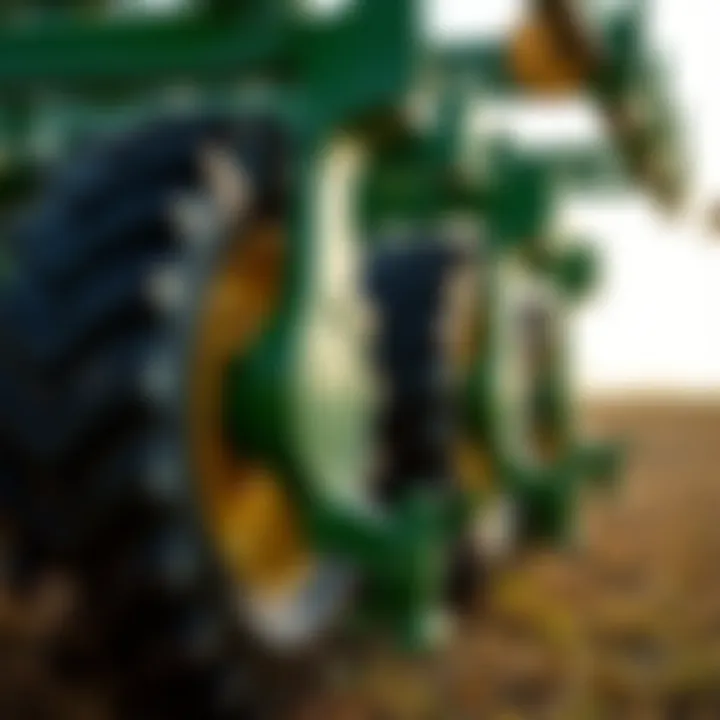
- Sequential Raking: Organizing the raking process into successive passes can help in managing larger areas effectively. For instance, raking in multiple rounds can ensure a more thorough collection without missing any patches.
- Utilize GPS Technology: Many modern models come equipped with GPS systems to enhance efficiency and precision. This technology helps farmers avoid overlap, minimizing wasted time and resources.
- Regular Maintenance: Keeping the wheel rake in the best shape influences productivity directly. Regular checks on tire pressure and rake wheel alignment can help ensure that the equipment operates smoothly and with maximum efficiency.
- Experiment with Timing: Finding the ideal time of day for raking can lead to better results. Raking early in the morning or later in the afternoon, when temperatures are cooler, may prevent moisture retention and improve the quality of the collected hay.
By focusing on these factors, farmers can not only improve the efficiency of their rakes but can also contribute positively to the overall yield and quality of their hay production operations.
"A well-timed wheel rake can make the difference between a good yield and a great one."
In summary, understanding and optimizing the operational efficiency of John Deere wheel rakes can greatly enhance one’s agricultural practices. By considering the right speed, the appropriate conditions, and implementing productive techniques, farmers can elevate their operations significantly.
Maintenance Practices for Longevity
Maintaining your John Deere wheel rake is more than just a good idea; it's essential for its continued functionality and longevity. This equipment works hard, and keeping it in tip-top shape ensures that it operates efficiently season after season. Understanding the nuances of maintenance not only minimizes the risk of unexpected breakdowns but also maximizes your investment in this vital agricultural tool. In agriculture, you can’t afford downtime, whether it’s due to machinery failure or other factors. Thus, establishing a maintenance routine becomes a cornerstone of operational success.
Routine Maintenance Checklist
When it comes to maintaining a wheel rake, a methodical approach is necessary. Here’s a handy checklist to keep in mind:
- Daily Checks: Inspect the rake wheels for any signs of wear or damage. Look for cracks or excessive wear on the tines.
- Lubrication: Ensure that all moving parts are adequately lubricated. This will facilitate smooth operation and extend the lifespan of the components.
- Tire Pressure and Condition: Check tire pressure regularly, as correct inflation affects the performance and efficiency of the rake. Inspect for any visible damage or wear.
- Adjustments: Make necessary height and angle adjustments before operating the rake to achieve optimal performance based on the field conditions.
- Cleaning: Remove debris and residue after each use to prevent corrosion and buildup. A clean machine is a happy machine.
By maintaining this checklist, operational hitches can be kept at bay, allowing the mower to work like clockwork.
Repair Tips and Troubleshooting
Every piece of equipment can run into snags. The key is to identify problems early and tackle them head-on. Below are some common issues you might encounter with John Deere wheel rakes and how to address them:
- Noise During Operation: Unusual sounds could signal a problem with the bearings or components that may not be lubricated well. Stop the rake and inspect for any loose bolts or damaged parts.
- Inconsistent Raking: If the rake isn’t gathering hay as effectively, it may be due to misalignment or height settings. Adjusting the rake’s angle or pressure could remedy the situation.
- Wheel Failure: If a wheel stops rotating, check for blockages in the drive components or see if the bearings need replacement. Prolonged neglect can exacerbate existing issues.
- Jammed Tines: If tines are becoming clogged, it may necessitate a more thorough cleaning. Regularly inspecting and maintaining them ensures they function properly.
In case you face persistent issues that you can’t resolve, consulting the John Deere’s manual or seeking professional assistance can save you from a headache down the line.
The time invested in maintenance can save you greater time and money in the long run.
A well-maintained wheel rake not only enhances productivity, but it also reflects the care and commitment of the operator towards their farming practices.
Comparative Analysis of John Deere Wheel Rakes
Understanding the landscape of agricultural equipment most notably involves assessing the options available in the market. A comparative analysis of John Deere wheel rakes is paramount for anyone looking to maximize efficiency and productivity in their operations. Several considerations come into play when choosing the right wheel rake, ranging from pricing and features to overall adaptability and reliability. This analysis not only highlights the distinct qualities that set John Deere apart but also provides insights into how it measures against its rivals.
Key Competitors in the Market
The field of agricultural equipment is conditioned by some major players, each presenting various models that cater to farmers' diverse needs. Some of the notable competitors of John Deere wheel rakes include:
- Vermeer: Known for innovation in hay and forage tools, Vermeer offers a line of wheel rakes that highlight ease of use and efficiency.
- H&S Manufacturing: This company focuses on strong, durable builds in their wheel rakes, providing reliability that farmers trust in tough conditions.
- Tedders: With an emphasis on versatility, Tedders provides models that can be adjusted for different applications, from small farms to larger operations.
- Haybuster: Often preferred for their robust designs, Haybuster wheel rakes target durability and continuous operation in the thick of farming seasons.
When it comes to the sheer breadth of user preferences and farm types, these brands serve as a good reference for comparison when evaluating John Deere products.
Strengths and Weaknesses
The strengths and weaknesses of John Deere wheel rakes are pivotal in shaping a user's decision-making process.
Strengths:
- Reputation and Reliability: John Deere is synonymous with quality in agriculture. Farmers have long considered their products dependable, standing the test of time in various conditions.
- Innovative Features: Models often come equipped with the latest technological advancements. For instance, they might include quick-change tines or flexible wheel configurations that provide better performance on uneven terrain.
- Comprehensive Support Network: Farms using John Deere products are often able to easily access support and parts, fostering smoother operations and maintenance routines.
Weaknesses:
- Higher Pricing: While John Deere prides itself on quality, the price tag might be a stumbling block for some, especially new farmers or those with tighter budgets.
- Service Availability: In less populated areas, service points might be scarce, limiting ease of access to repairs and maintenance.
- Weight: Some users have reported that certain models can be heavier compared to competitors, which can affect transportability in specific situations.
User Experiences and Testimonials
User experiences and testimonials serve as a vital component when evaluating the effectiveness of agricultural equipment like the John Deere wheel rake. Understanding firsthand accounts from farmers who utilize this machinery adds a depth of insight that specifications and technical data alone cannot provide. These narratives reveal not just the operational efficacy, but they also shed light on aspects such as reliability, ease of use, and performance under varying conditions. Furthermore, user experiences help prospective buyers gauge the long-term satisfaction and value that comes from their investment, helping them make informed choices.
Case Studies from Farmers
Farmers often share stories about their experiences with John Deere wheel rakes, offering a variety of perspectives based on their unique operations. Take, for instance, the experience of Alice, a seasoned hay producer in Ohio. After switching to the John Deere 1133 Wheel Rake, she noticed a significant uptick in the efficiency of her hay production.
"Switching to the 1133 has been a game-changer. It accommodates larger areas, and with its adjustable tines, I can easily adapt to different hay types without a hitch," Alice states.
On the flip side, Joe, who farms in North Dakota, faced challenges when transitioning from a traditional rake to a wheel rake. He initially struggled with the operational differences but quickly adapted after a few tries. He notes, "Once I got a hang of the machine, it improved my output dramatically. It really takes the cake for reliability during peak harvest times."
These experiences highlight not only the importance of adaptability in machinery but also the learning curve that can accompany new equipment. Such case studies reflect the diversity of agricultural settings and help potential users relate their own situations to others in the field.
Shared Insights on Performance
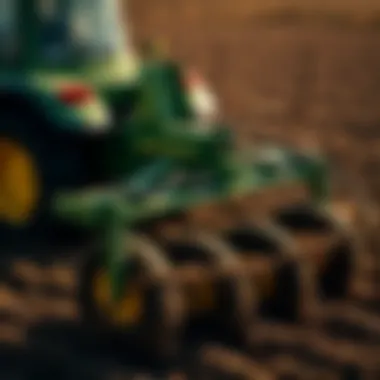
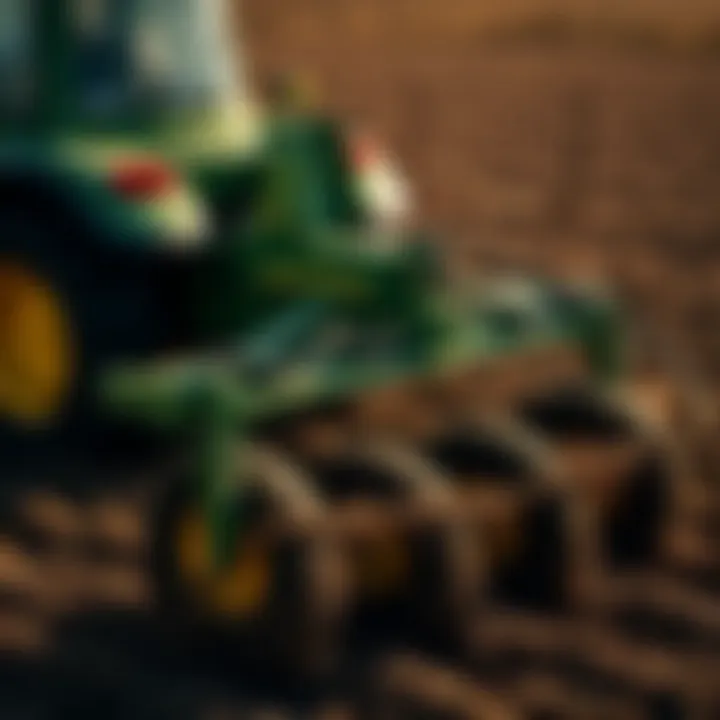
Insights gathered from various farmers reveal common themes surrounding the performance of John Deere wheel rakes. For instance, many users emphasize the importance of maintenance in sustaining efficiency. Regular upkeep is consistently mentioned as a key factor in ensuring the rake performs optimally throughout the season.
Farmers also often discuss the durability of the construction materials used in these rakes. For example, Ethan, a farmer from Kansas, remarked that the heavy-duty frame withstands tough conditions well, stating, "I've driven it through muddy fields, and it just keeps going. It’s built like a tank!"
Moreover, ease of operation has emerged as a central theme. Users appreciate features like the intuitive height adjustment mechanism, which allows them to tailor the rake’s performance based on specific crop conditions, thus minimizing crop damage. Many farmers have echoed sentiments like, "Once I'm set up, it's as easy as pie to maneuver."
In summary, user experiences and testimonials around the John Deere wheel rake are rich with practical knowledge. They act as a guide not just for prospective buyers, but also for current users looking to optimize their experience with the equipment. These narratives enrich the understanding of the rake's capabilities and limitations, offering a well-rounded view of its role in modern agriculture.
Financial Considerations and Investment
Understanding the financial implications of investing in a John Deere wheel rake is essential for farmers looking to optimize their operations. This section highlights key aspects that must be taken into account, including the cost of different models and their potential return on investment. By assessing these factors, farmers can make informed decisions that not only enhance productivity but also align with their budgetary constraints.
Cost Analysis of Different Models
When delving into the specifics of each wheel rake model, a clear picture emerges regarding the cost structures. Different John Deere wheel rakes cater to various needs, capabilities, and price points. Take, for example, the John Deere 1550 and the 1690 models; while both serve the dual purpose of efficiently raking hay, their costs differ due to varying features and capacities.
- John Deere 1550 Wheel Rake: Priced around $8,000 to $10,000, this model provides a balance of functionality and affordability. It's suitable for smaller operations that require reliable performance without breaking the bank.
- John Deere 1690 Wheel Rake: In contrast, this model can range from $13,000 to $15,000, but with added features like adjustable raking width and higher durability. Although the upfront cost is steeper, the investment can lead to longer-term savings through enhanced efficiency and lower maintenance costs.
This varied pricing indicates that farmers should conduct a thorough cost-benefit analysis, weighing each model’s features against their specific operational needs.
Return on Investment Assessment
Calculating the return on investment (ROI) is vital to understanding whether purchasing a wheel rake is a financially sound decision. Farmers need to consider not just the purchase price, but also operational costs, maintenance, and potential revenue generated from increased hay production.
For instance, a farmer who opts for a John Deere 1690 might invest more initially, however, the larger rake capacity allows for more efficient hay collection, reducing the time spent in the field. This efficiency can translate to:
- Increased Yield: More hay harvested per hour leads to higher overall production.
- Labor Savings: With the ability to handle larger volumes, fewer hours are needed from laborers, effectively lowering labor costs over time.
- Quality of Product: Better raking can lead to higher quality hay, which could fetch better market prices.
Investing in quality equipment like John Deere wheel rakes often pays off in the long run. While initial costs may seem high, the savings generated from improved efficiency and productivity can make all the difference.
Farmers should also keep in mind the longevity of their investment. The durability that comes with John Deere products usually means lower replacement rates and less frequent repairs. This further improves the ROI, which should be a key consideration when assessing any agricultural equipment.
Ultimately, understanding the financial considerations and investment of a John Deere wheel rake can ensure that decisions made are not only for immediate agricultural needs but also beneficial in the long term. By examining both cost and potential returns, farmers can better align their investments with their operational goals.
Innovations and Future Trends
In the ever-evolving field of agriculture, keeping pace with the latest innovations is essential for enhancing efficiency and sustainability. The advancements in John Deere wheel rake technology not only showcase the brand’s commitment to quality but also address the growing needs of modern farming. With climate challenges and the increasing demand for food production, it’s more important than ever that these agricultural tools adapt and evolve.
The integration of advanced technology in wheel rakes presents numerous benefits. Farmers can achieve better crop yields with tools designed for efficiency and precision. Innovations encompass everything from enhanced design features to smart technology that assists in operational decision-making. By examining these trends, we can understand how John Deere is carving a path forward for agricultural implements.
Technological Advancements in Design
Recent years have seen significant leaps in the design of wheel rakes, particularly those from John Deere. These machines have incorporated smarter, more user-friendly features that not only increase functionality but also elevate the user experience. For instance, adjustable rake arms allow for precise control over the raking process—ensuring optimal hay collection despite varying ground terrains and conditions.
Moreover, many models are now equipped with sensors that provide real-time data feedback. This feature allows farmers to monitor their rake’s performance on the go, making it easier to adjust settings for maximum productivity. The automation of some processes also means reduced physical strain during operation, making it easier for operators of all ages to manage heavy work loads effectively.
Additionally, sleek designs have improved the aerodynamics of these rakes, allowing for less fuel consumption when towed by tractors. This efficiency not only ensures better performance but can lead to cost savings for farmers, making the investment in advanced technology worthwhile in the long run.
Sustainability Practices in Manufacturing
As environmental concerns gain traction globally, John Deere is also aligning its manufacturing processes with sustainability principles. Innovative practices emerge as essential components for a future-focused agricultural industry. For example, some wheel rakes now utilize recycled materials in their construction, reducing waste and promoting responsible resource use.
Furthermore, the manufacturing processes have been refined to minimize energy consumption. This can encompass everything from advanced machinery that reduces raw material wastage to implementing renewable energy sources within production facilities. Such changes demonstrate John Deere’s commitment to making a positive environmental impact, an increasingly important consideration for both consumers and manufacturers alike.
These sustainable practices extend beyond manufacturing; they resonate across the farming community, where the adoption of eco-friendly technologies is becoming a norm. By investing in equipment that prioritizes sustainability, farmers are not only enhancing their productivity but also taking an active role in protecting the environment for future generations.
In sum, innovations in technology and sustainable manufacturing practices stand at the forefront of the John Deere wheel rake’s evolution. These changes provide farmers with crucial tools to meet modern challenges while fostering a commitment to environmental stewardship. The landscape of agriculture continues to transform, and John Deere is well-positioned to lead that charge with their forward-thinking approaches.
Ending: The Role of John Deere Wheel Rakes
As we reach the end of our comprehensive exploration, it's clear that John Deere wheel rakes play a vital role in modern agricultural practices. They are not just machines; they’re extensions of the farmer's capabilities, transforming the hassle of haymaking into a more streamlined process. Understanding their significance can enhance efficiency and productivity on any farm.
The restructuring of hay with wheel rakes ensures clean, consistent bales ready for storage or sale. What sets the John Deere models apart is not just their construction but their user-oriented design and adaptability to various farming conditions. Moreover, the emphasis on durability and ease of maintenance means farmers can rely on their wheel rakes season after season without the fear of unexpected breakdowns.
This conclusion isn’t merely about summarizing features; it’s about appreciating how John Deere wheel rakes support agricultural communities by facilitating better hay production.
Summary of Key Points
In recap, several elements can be highlighted:
- Durability and Build Quality: The robust construction materials ensure longevity and resistance to wear.
- Operational Efficiency: Optimal speed and rake configurations enhance productivity, tailored to the user's specific farming conditions.
- Ease of Maintenance: The straightforward mechanics provide farmers with a maintenance routine that minimizes downtime.
- User Experience: Positive testimonials and case studies underline the real-world performance and dependability of these machines.
Final Considerations for Farmers
For farmers looking into investing in a wheel rake, the following should be considered:
- Assess Your Needs: Evaluate the size of your hay production operation and choose a model that matches your scale.
- Consider Local Terrain: Understanding the varying conditions in your fields will help in deciding the rake configuration that best suits your environment.
- Budget for Maintenance: Regular upkeep is necessary to ensure your machine operates optimally. Set aside resources for potential repairs or enhancements down the line.















